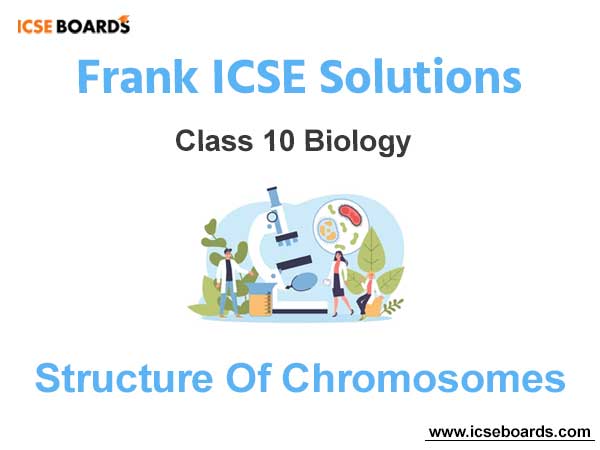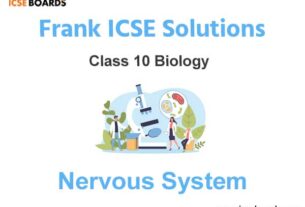Question 1: What is chromatin?
Solution 1:
The highly Extended and elaborate nucleoprotein fibres are present inside the nucleus are called chromatin.
Question 2: How is chromatin observed in an interphase cell?
Solution 2:
The chromatin appears as a network of long, extremely thin filaments in interphase.
Question 3: What happens to chromatin during prophase and metaphase of mitosis?
Solution 3:
During prophase, condensation of chromatin material take place each chromosome appears double and consists of two collider sister chromatid joined by the centromere during metaphase, the chromosome contain two chromatid attached to each other through the centromere chromosome during the stage at thickest and the shortest, all the chromosomes align themselves at the eQuestion uator the plane of alignment of centromere of all the chromosomes of the cell at metaphase is referred as ametaphysics plate.
Question 4: What are chromosomes? Why are they called so?
Solution 4:
Chromosomes are the thread like structures which is present within the nucleus. Chromosomes get their name from how Question uickly they absorb and stain certain basic dyes. The word chromosome is derived from the Greek words “chromos” (colour) and “soma” (body).
Question 5: Mention the contribution of the scientists given below in the study of chromosomes:
(i) Strasburger
(ii) Balbiani
(iii) Waldeyer
(iv) Sutton and Boveri
Solution 5:
1. Strasburger – during cell division he observed thread like structures
2. Balbiani – Described rod like structures in nucleus before cell division.
3. Waldeyer – is credited with coining the word “chromosomes.”
4. Sutton and Boveri – defined chromosomes as physical structures and genetic trait transmitters.
Question 6: Briefly mention the structure of a typical chromosome.
Solution 6:
Chromosome consists of two identical halves the chromatids which are held together at once point called centromere. The centromere appears as a narrow region called primary constriction, of the chromosome on the side of centromere disc shaped structure are present known as Kinetochore.
End of the chromosome are called telomeres. They seal the end of chromosomes and prevent the shortening or chromosome loss. Depending on the position of the centromere chromosomes can be classified into four types.
1. Metacentric chromosome
2. Sub metacentric chromosome
3. Acrocentric chromosome
4. Telocentric chromosome network

Question 7: Write a sentence about each of the following:
(i) Sheath
(ii) Matrix
(iii) Chromonemata
(iii) Centromere
(v) Secondary constriction
(iv) Telomere
Solution 7:
1. Sheath – The proteinaeous sheath that protects the chromosomes.
2. Matrix – A granular substance found within the sheath.
3. Chromonemata – Chromonemata are chromatid elements.
4. Centromere – The chromatid of the metaphsic chromosomes are held together at one point called centromere.
5. Secondary Constriction – A secondary constriction is a constriction that is not the same as a primary constriction.
6. Telomere – Telomeres are the ends of the chromosomes.
Question 8: At which stage are chromosomes best observed?
Solution 8:
At metaphase Chromosomes are best observed.
Question 9: What are autosomes? How many are present in man?
Solution 9:
The chromosomes other than sex chromosomes present in the body are called autosomes. 22 pairs of autosomes are present in man.
Question 10: What do you understand by sex chromosomes?
Solution 10:
The chromosomes which determine the individual’s sexuality are called sex chromosomes.
Question 11: How are sex chromosomes significant?
Solution 11:
Sex chromosomes are significant as they determine the individual’s sexuality.
Question 12: What are the sex chromosomes in man?
Solution 12:
There are two sex chromosomes in each person. Males have X and Y chromosomes, while females have X and X chromosomes.
Question 13: Give the importance of chromosomes as hereditary material.
Solution 13:
Chromosomes are the primary source of chemical information that decides that the cell should become like its parent cell.
They also determine that the organism’s cells will provide the animal or plant its species-specific characteristics during the developing period.
Question 14: Name the two nucleic acids. Who discovered them?
Solution 14:
DNA and RNA are the two nucleic acids. Frederick Miescher discovered DNA
Question 15: What are nucleic acids made of?
Solution 15:
Nucleic acids are constituted of three types of molecules:
1. a pentose sugar
2. nitrogenous bases
3. a phosphate
Question 16: What is the Chemical composition of chromosomes?
Solution 16:
The chemical composition of chromosome consists of:
1. Approximately 40% of DNA and 50% of Histone proteins.
2. Non-histone proteins account for 8.5 %.
3. Magnesium and calcium ions are present in trace amounts.
Question 17: Mention the names of the nitrogen bases present in DNA.
Solution 17:
Two nitrogenous bases present in DNA are:
1. Purines – Adenine and Guanine.
2. Pyrimidines – Cytosine and Thymine.
Question 18: Mention three differences between DNA and RNA.
Solution 18:
Below are the difference between DNA and RNA:-
Question 19: Write a short note on the features of DNA.
Solution 19:
Features of DNA:
DNA is made up of two strands that are spiralled around an axis. A double helical arrangement is what it’s called.
Nitrogenous bases, pentose sugar, and phosphate make up each DNA strand.
Adenine, guanine, cytosine, and thymine are the bases; sugars are of the pentose type.
Hydrogen bonds bind the two strands together. Between adenine and thymine, there are two bonds, while between guanine and cytosine, there are three.
Bases are on the inside of DNA, sugars are on the outside, and two sugars are linked by phosphoric acid.
Each DNA strand replicates, resulting in the formation of new DNA. This is referred to as DNA replication
Question 20: Who described the detailed structure of DNA?
Solution 20:
Watson and Crick described the detailed structure of DNA.
Question 21: What is the importance of DNA?
Solution 21:
Importance of DNA:-
1. DNA is a hereditary material.
2. It helps in variation that occurs due to crossing over at the time of meiosis.
3. Controls of metabolism growth and differentiation.
4. Presence of enzymes which forms m RNA which act as a messenger.
Question 22: What are the rungs of the “DNA ladder” made of?
Solution 22:
The rungs of “DNA ladder” are made up of two types of nitrogenous bases:
1. Purines: Adenine and Guanine
2. Pyrimidines: Cytosine and Thymine.
Question 23: Name the repeating components of each DNA strand lengthwise.
Solution 23:
Pentose sugar and phosphate group
Question 24: Fill in the blanks:
(i) DNA replicates in the ______ of the cell cycle.
Solution:
DNA replicates in the Interphase of the cell cycle.
(ii) Chromatin fibre is made up of DNA and ______.
Solution:
Chromatin fiber is made up of DNA and histone proteins.
(iii) There are two nucleic acids ______ and ______.
Solution:
There are two nucleic acids RNA and DNA.
(iv) DNA acts as director of ______ synthesis.
Solution:
DNA acts as director of Protein synthesis.
(v) DNA stands are made up of, pentose sugar and four types of ______ bases.
Solution:
DNA stands are made up of, pentose sugar and four types of Nitrogen bases.
Question 25: State whether the following sentences are true or false:
(i) Each spiral of the DNA has 12 nucleotides.
Solution:
False
(ii) The two DNA chains are parallel to each other.
Solution:
False
(iii) Genes are arranged in a linear order on a chromosome.
Solution:
True
(iv) In any specimen of DNA, the total molar amount of A + G = T+ C.
Solution:
True
Question 26. Label the lettered parts of the given figure and answer the following questions:
(i) What does this diagram represent?
(ii) What is the importance of’ d’?
(iii) What are the ‘staining’ properties of ‘b’ and ‘c’?
(iv) Who gave the term used for this structure today?
(v) What is a?
(vi) Is ‘e’ present in all chromosomes?

Solution 26:
1. The diagram depicts the chromosomal structure.
2. The centromere is the part of the cell that attaches to the spindle fibres.
3. ‘b’ represents heterochromatin, which is a deeply stained region when stained with acetocarmine, and ‘c’ represents euchromatin, which is weakly stained when stained with acetocarmine or felugen.
4. Waldeyer
5. Matrix
6. No, secondary constriction, also known as ‘e,’ is not found on all chromosomes.
Question 27: Choose the correct answer:
(i) The network of fine threads in nucleus is called
(a) chromosome
(b) chromonemata
(c) chromatid
(d) chromatin
Solution:
Chromatin
(ii) The term ‘chromosome’ was coined by
(a) Balbiani
(b) Darwin
(c) Waldeyer
(d) Sutton and Boveri
Solution:
Waldeyer
(iii) The primary constriction contains:
(a) centromere
(b) centriole
(c) chromatid
(d) telomere
Solution:
Centromere
(iv) This structure is not present in all chromosomes
(a) centromere
(b) chromonemata
(c) secondary constriction
(d) telomere
Solution:
Secondary constriction
(v) Chromosomes are thin and thread like at
(a) interphase
(b) metaphase
(c) anaphase
(d) pachytene
Solution:
Interphase
(vi) Thick short chromosomes can be observed at (in mitosis)
(a) metaphase
(b) telophase
(c) anaphase
(d) prophase
Solution:
Prophase
(vii) Chromosomes largely consist of
(a) DNA and histones
(b) DNA and RNA
(c) RNA and histones
(d) histones and ions
Solution:
DNA and histones
(viii) Chromosome number of man is
(a) 46
(b) 23
(c) 64
(d) 45
Solution:
46
(ix) Telocentric chromosomes are
(a) I shaped
(b) V shaped
(c) J shaped
(d) L shaped
Solution:
I shaped
(x) A ‘V’ shaped chromosomes has to
(a) acrocentric
(b) metacentric
(c) telocentric
(d) sub-metacentric
Solution:
Metacentric
(xi) Sex chromosomes in man are
(a) XX
(b) YY
(c) XY
(d) none of these
Solution:
XY
(xii) Sex of an individual is determined by
(a) autosomes
(b) sex chromosomes
(c) lampbrush
(d) polytene chromosomes
Solution:
Sex chromosomes
(xiii) DNA model was given by
(a) Watson and Crick
(b) Sutton and Boveri
(c) Balbiani and Darwin
(d) Waldeyer and Carlson
Solution:
Watson and Crick
(xiv) Adenine is a
(a) nitrogen base
(b) pentose sugar
(c) fatty acid
(d) enzyme
Solution:
Nitrogen base
(xv) Which of these is not present in DNA?
(a) Adenine
(b) Thymine
(c) Uracil
(d) Cytosine
Solution:
Uracil
(xvi) RNA has uracil instead of
(a) adenine
(b) thymine
(c) guanine
(d) cytosine
Solution:
Thymine
(xvii) Spirally coiled double strands are observed in
(a) DNA
(b) chromosome
(c) RNA
(d) chromatin
Solution:
DNA






